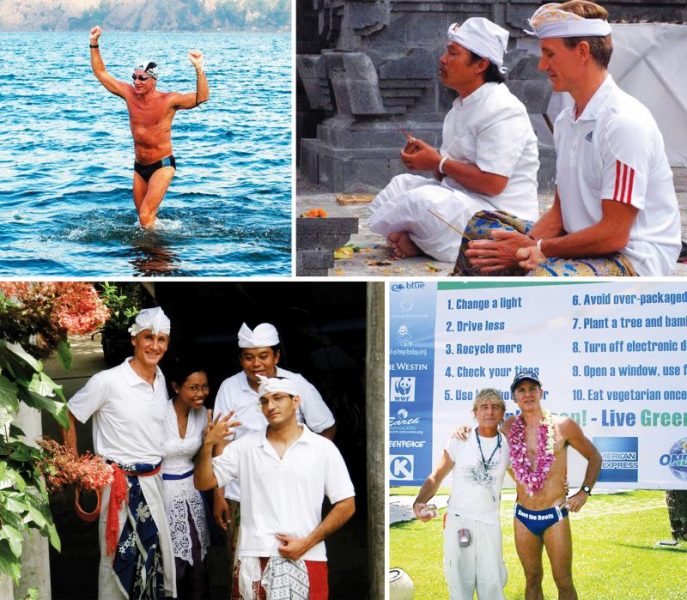Monte
Few foreign athletes have devoted themselves to humanitarian and environmental causes in Indonesia as much as Montgomery Monfore, an American world record ocean swimmer, who spent much of the past 20 years in Bali.
Monte, as he was known, made numerous record-breaking charity swims to raise awareness and funds for environmental and social campaigns in Indonesia. His untimely passing in October 2017 on Rota Island in the North Pacific Ocean was ruled accidental, though the autopsy report has led family and friends to question its veracity.
Born in 1961 in Fresno, California, Monte excelled at swimming from a young age. At high school, he was an All-American in swimming and water polo. He held all of his high school’s swimming records except two, and three decades later, five of his records remained unbroken. He also achieved state records. Disappointed by the US boycott of 1980 Moscow Olympics, he retired from competitive swimming.
Monte studied social science at the University of California, Berkeley, where he starred in the water polo team. After graduation in 1984, he worked as an English teacher in Japan. He also escorted groups of Japanese tourists on visits to the United States. After a ten-year hiatus, he joined the Masters Swimming international competition for two years, picking up more than a dozen national records, culminating with a Masters’ world record for the 400-metre individual medley in 1991.
After taking up long-distance ocean swimming, he crossed the treacherous 19.5-kilometre Tsugaru Strait between Honshu and Hokkaido in northern Japan. Despite strong currents, stormy weather and brutal swells, he completed the swim in under 15 hours. He became only the third person to cross the channel, but his swim was listed as unofficial because he had boarded a support boat for a few minutes of treatment after being stung by a Portuguese man-o-war.
Activism
Always a free spirit, Monte was reluctant to be tied down by an office job. After a trek in Nepal in the early 1990s, he visited Bali, attracted by its warm equatorial waters. The island and its people captured his heart. Living in Bali deepened his love of ocean swimming. It also spurred him to become involved in environmental activism and social causes. His introduction to conservation came from an American environmentalist, Robin Marinos, who was his neighbour in Legian. They had first met at Blue Ocean Beach, where Monte’s body surfing skills drew onlookers. “He was a tremendous body surfer, the best I ever met,” says Robin. “When the tide was going back in and the huge waves were dumping, he’d go out there and swim behind the waves, and once in a while he’d catch one. He was the only guy out there. People used to sit out there and say, who’s that crazy guy out in the water? He was a very noticeable person.”
At that time, Robin was investigating the commercial slaughter of protected green sea turtles at Tanjung Benoa peninsula. Monte joined in rescue missions at illegal beachside slaughterhouses, where he witnessed the suffering of tied and mutilated turtles. He also became concerned about pollution and reef destruction in Indonesian waters. A subsequent trip through Java opened his eyes to poverty and malnutrition. Upon his return to Bali, he decided to undertake humanitarian activities, utilizing his ocean swimming skills to raise funds. He spent a lot of time looking for corporate sponsors and getting them.
In 1998, when 37 years old, Monte made his first charity swim, crossing from Bali to Java in a record time of just 38 minutes, smashing the previous record of 1 hour and 36 minutes. The convergence of the Indian Ocean and the Java Sea creates dangerous currents in the Bali Strait, which is 3 km at its narrowest and widens to 6 km. Monte timed his swim to take advantage of the current, but even then he was still pulled off-course. “The current was stronger than I anticipated and I ended up 6 km further south than I anticipated. While I swam the extra distance, I was assisted by the current,” he explained.
As his childhood friend John Blair later recalled, Monte was a natural swimmer with a beautifully smooth technique and an incredible feel for the water, enabling him to glide through water. “He can swim across the pool easier than most people can walk across the street,” said John.
When performing charity swims, Monte adhered to international channel swimming rules: no fins, no wetsuit and no touching support boats. He swam not for personal glory, but to gain attention for important causes. He also inspired and encouraged others to swim and become involved in charitable causes. His blonde hair, blue eyes and muscular physique won him plenty of female admirers, but he remained a bachelor, reluctant to settle down.
In 2003, Monte made the 17 km swim across the Badung Strait between Nusa Penida Island and Bali in a record time of 2 hours and 46 minutes. His friend Robin was on the support boat and decided to join him for the final 300 metres of the swim, but the current was so powerful that Robin had to be rescued by the boat, whereas Monte continued to slice through the water. He used publicity generated by the swim to campaign for conservation of oceans and reefs. “Awareness and diligence are necessary to safeguard this vital ecosystem, the protection of which is essential to mankind’s existence and survival,” he told Tempo magazine.
By 2004, Monte had become a resident of Bali. He promoted children’s nutrition and education, and supported the Advice for Life orphanage and Baitul Muslimin orphanage, as well as Bali Community Cares, which supports children of HIV/AIDS patients. He was also concerned by the lack of water skills among children and provided swimming lessons.
Although offered employment as a diving guide and swimming coach, Monte was too restless to accept extended periods of contracted employment. He lived life to his own rhythm. He was a generous man, often too generous, helping needy individuals and those with hard-luck stories, but he was not always repaid for his kindness.
His record-breaking ocean swims supported projects and initiatives undertaken by the United Nations, Greenpeace and the World Wildlife Fund. He championed the UN World Food Programme’s Global School Feeding Programme for hungry children, as more than one-third of child deaths in Indonesia are caused by under-nutrition.
In February 2005, Monte became a humanitarian swimmer for the One Ocean One World initiative. In May that year, he performed a 17 km swim to raise awareness for victims of the December 2004 Aceh tsunami that left about 84,000 people homeless. The following year, he completed his Bali Fight Hunger Swim, setting a record for a two-way crossing of the Bali Strait. He began the swim in darkness to symbolize that many people are unaware of world hunger. He finished at sunrise to represent hope that child hunger can be overcome. Despite adverse conditions, he set a new single-crossing world record of 29 minutes 30 seconds for the Bali to Java swim.
In late May 2006, an earthquake hit the ancient Javanese temple city of Yogyakarta, killing more than 5,700 people and leaving about 650,000 displaced and requiring urgent humanitarian assistance. Monte teamed up with the UN World Food Programme, performing in early June a 12.5 km swim over 4 hours and 4 minutes off the coast of Central Java from Menyawakan Island to Kumbung Island, raising funds and awareness.
Always keen for new challenges, Monte in October 2006 made the first ever recorded swim across Lake Batur in the highlands of Bali, raising funds from sponsors to alleviate poverty as part of United Nations Millennium Development Goals.
In 2007, aged 46 but showing no signs of slowing down, he made the 7-kilometer Lombok Strait Fight Hunger Swim from Lombok to Gili Trawangan Island as part of a World Food Programme initiative to support hungry schoolchildren. Swimming against strong currents, the gruelling swim took 2 hours and 10 minutes.
Monte made numerous other sponsored swims, notably his 2007 Reverse Climate Change Swim, covering the 6 km stretch from Serangan Island to Bali’s Nusa Dua. “The ocean is dying… Fifteen years ago I used to see dozens of reefs sharks and turtles every week. Now I rarely see them. The beautiful coral reefs are also dead or dying. The major cause of this destruction is global warming … which must be stopped,” he said.
He was modest about his achievements. “My main objective is to swim in support of environmental and humanitarian causes. Another thing I hope to achieve is, in a small way, contribute to a better understanding between people of different parts of the earth. I live on the Hindu island of Bali, for example, in the middle of the largest Muslim nation and third largest democracy in the world, and I see a different face of Islam than is often depicted on television screens across the globe. I’ve travelled throughout this archipelago and have experienced nothing but smiling faces and kindness. I love this beautiful country and its wonderful people and plan to spend the rest of my life here. And it’s my intention to promote Bali and Indonesia internationally with my swimming whenever possible.”
Over the years, Monte suffered from chronic fatigue syndrome. He often needed to sleep after training as a result of the pressure he put on his body. When he needed to swim against strong currents, he could override his fatigue. He was always careful when entering ocean water, never diving in head first, but always jumping in feet first to avoid potential head injuries.
In 2012, he gave his body a break and returned to California to spend time with his father, who had always been one of his closest friends and mentors. Yet Monte yearned to return to the tropical climate. In April 2017, he moved to Rota Island, where he planned a simple life. On 24 October, Monte was due to fly to Japan and his luggage had been loaded, but the flight was delayed due to bad weather. Shortly thereafter, he was found dead in a shallow recreational pool at a water park near a beach in Songsong, Rota. He was 56 years old. A local autopsy concluded death by accident from blunt force trauma to the head.
He is survived by his father, three sisters and a niece and nephew. He was a tremendous athlete, who had a way of making people feel good and bringing out their best. He loved Indonesia and carried no grudges, only a desire to protect the marine environment and help the needy.




